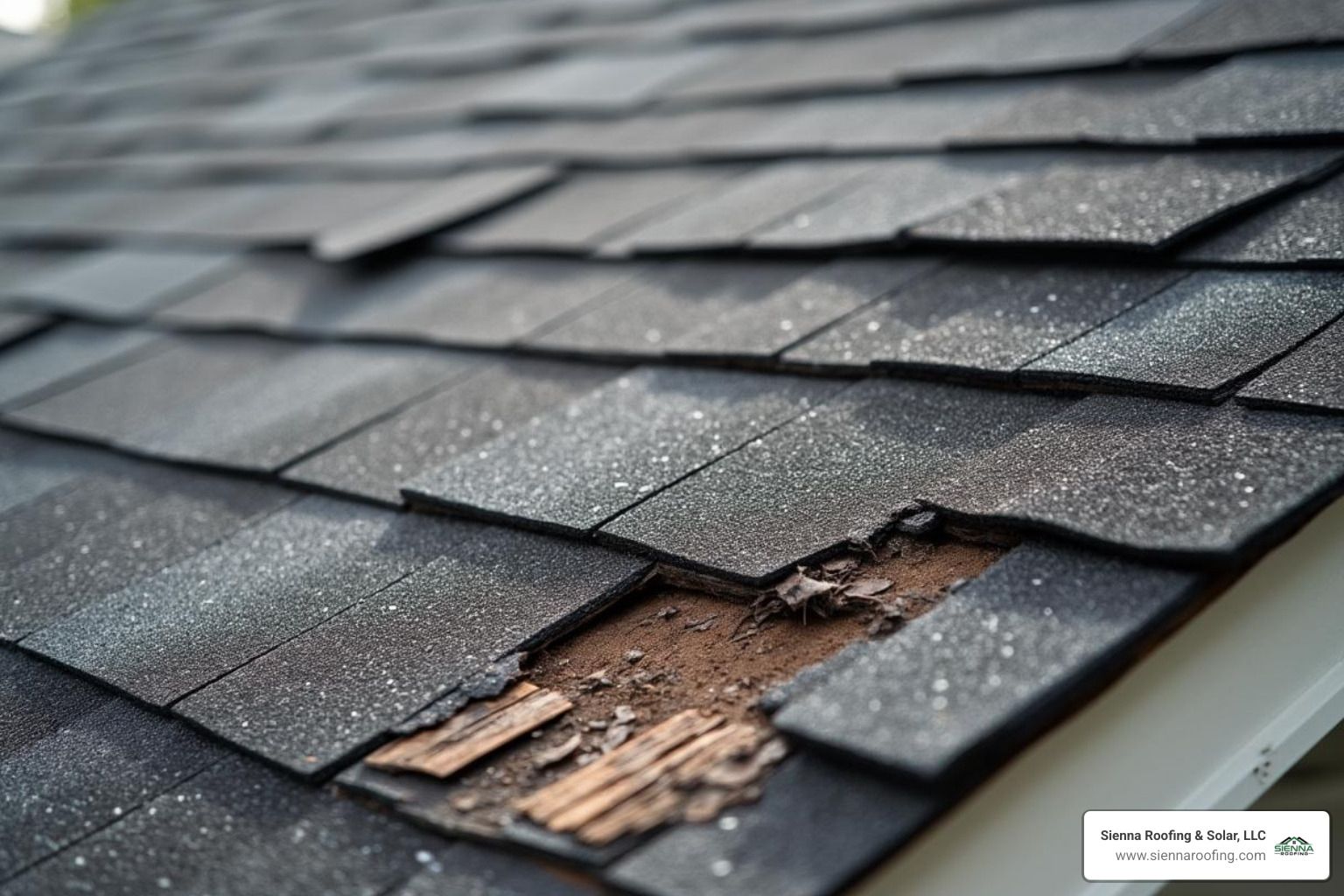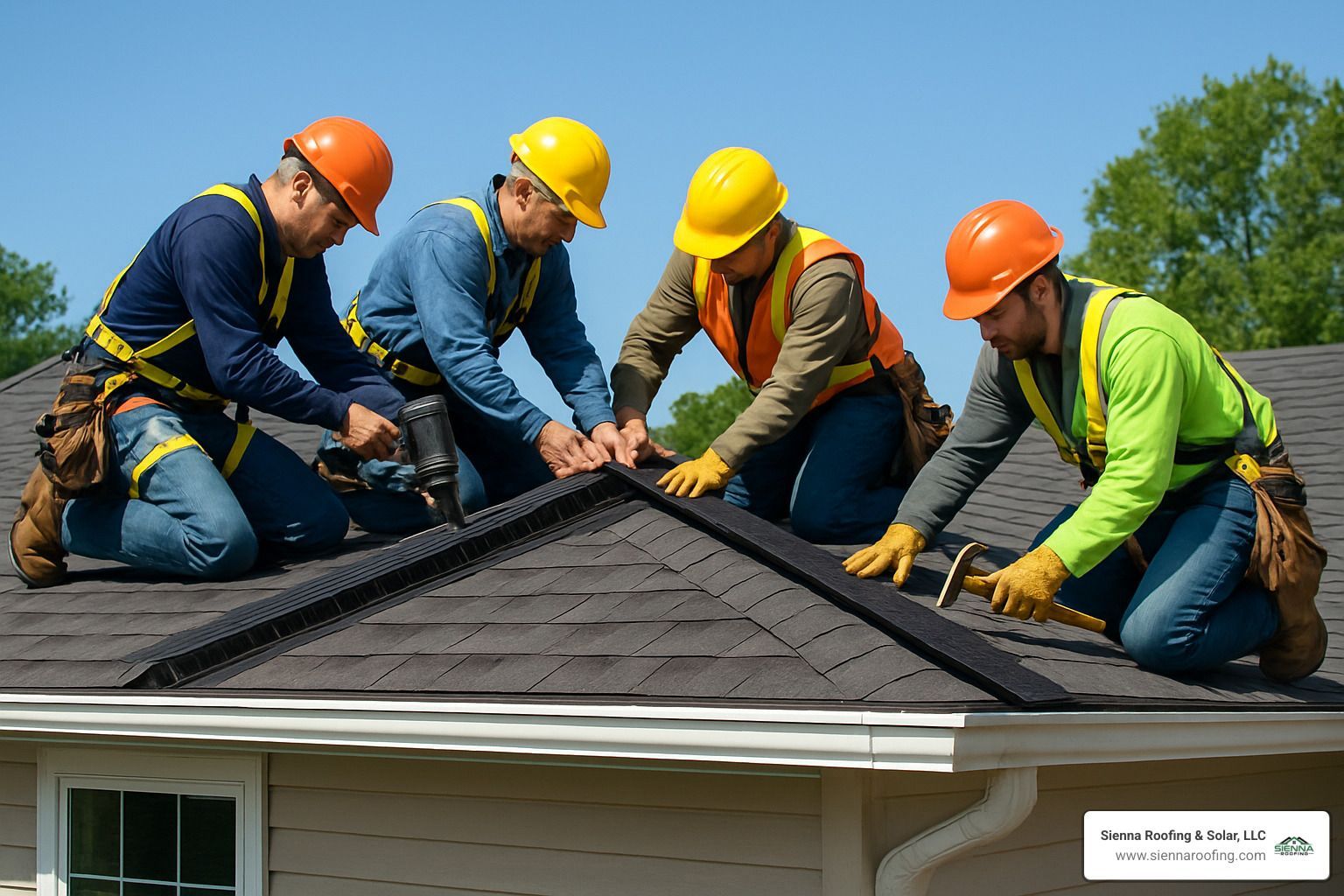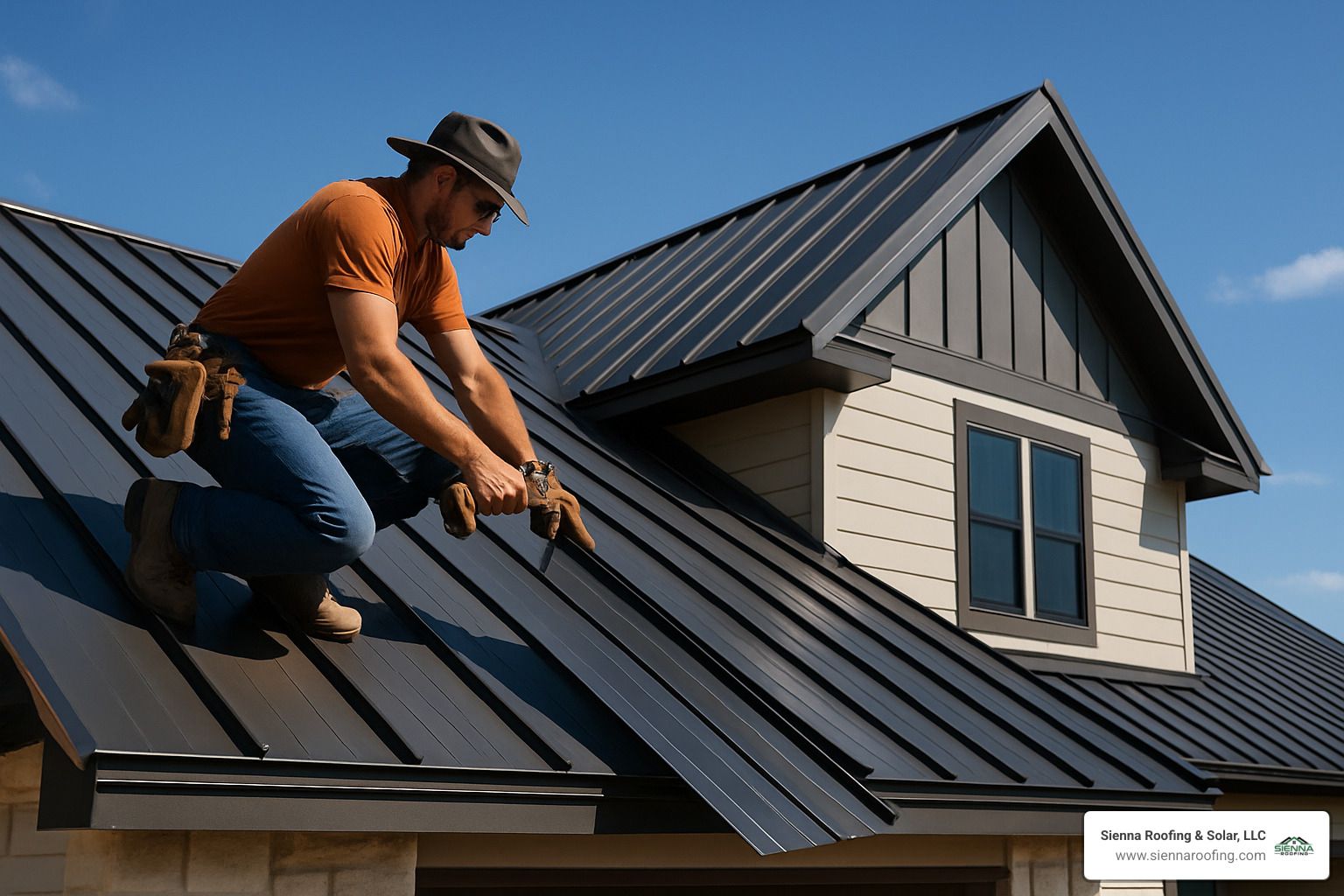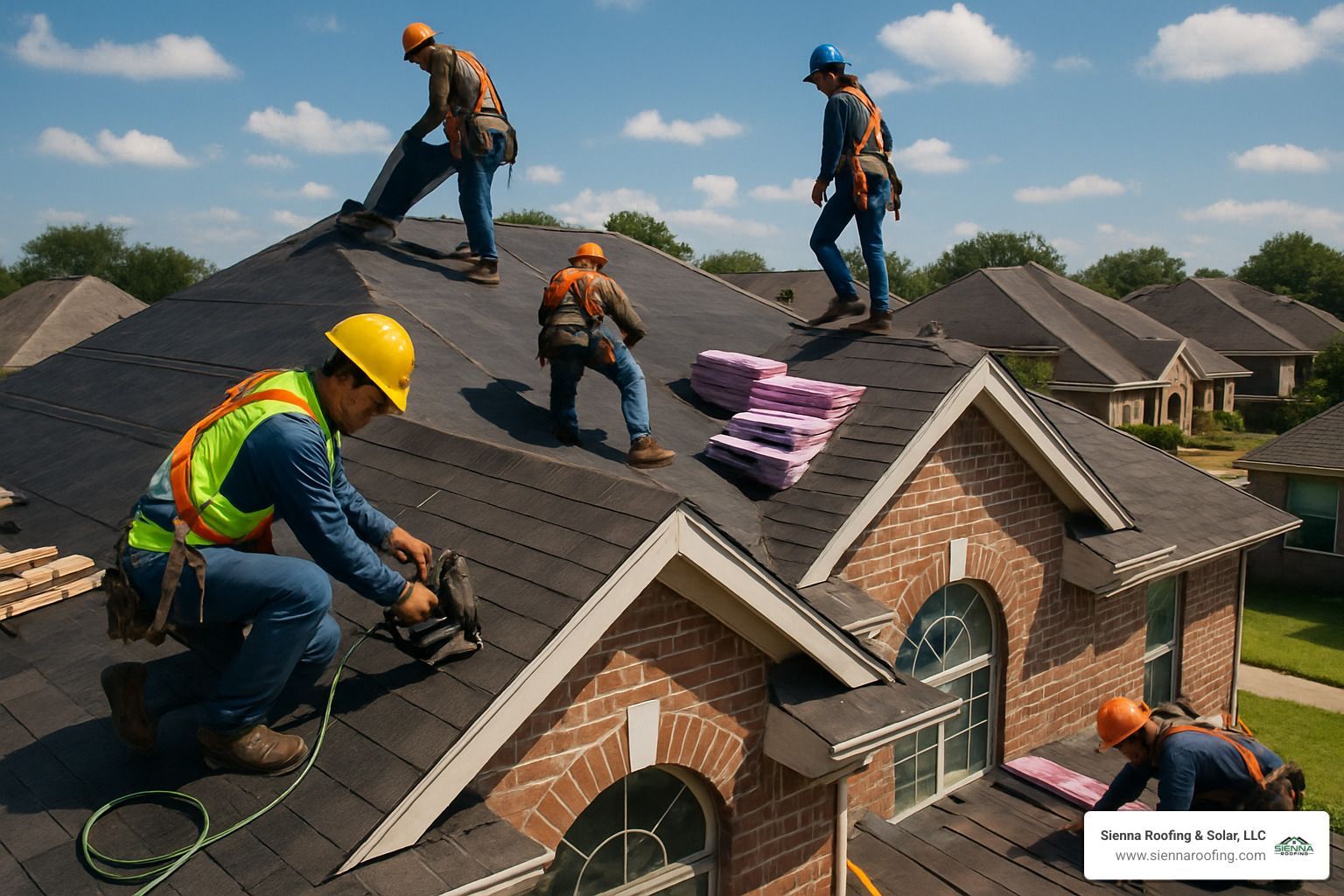How to Repair Storm Damaged Roof in 5 Simple Steps

Andre Castro
Owner of Sienna Roofing
Why Acting Fast After Storm Damage Saves Your Home
Storm damage roof repair requires immediate action to prevent minor issues from becoming major disasters. When Texas storms hit Sugar Land with hail stones traveling up to 100 mph, your roof takes a beating that can lead to expensive water damage, mold growth, and structural problems if ignored.
Quick Storm Damage Roof Repair Steps:
- Inspect safely- Check from ground level first, then attic
- Document everything- Photos, videos, detailed notes
- Make temporary repairs- Tarps, roofing cement for holes
- Call your insurance- File claims within policy deadlines
- Hire professionals- Licensed contractors for permanent fixes
Most homeowners have up to 3 years to file storm damage claims, but acting within days prevents further damage. Insurance companies typically cover wind, hail, and fallen tree damage - but only if you can prove the storm caused it.
The biggest mistake? Waiting for visible leaks. As one roofing expert notes: "Storm damage won't lead to an immediate leak; homeowners shouldn't panic, but they also shouldn't wait." Hidden damage like loose shingles or damaged flashing can cause problems months later.
I'm Andre Castro, CEO and founder of Sienna Roofing & Solar, LLC, with over five years of experience helping Sugar Land homeowners steer storm damage roof repair projects. My Construction Management background from Texas A&M and hands-on approach ensure every storm repair meets the highest standards while maximizing your insurance coverage.
5-Step Storm Damage Roof Repair Plan
When Texas storms roll through Sugar Land, they don't mess around. After helping hundreds of families steer storm damage roof repair across our community, I've learned that having a clear plan makes all the difference between a quick recovery and months of headaches.
The secret isn't just knowing what to do - it's knowing how to do it safely while protecting your insurance claim. Hail stones traveling at 100 mph can cause damage that won't show up as leaks for weeks or even months. That's why we've developed this systematic approach that keeps you safe while ensuring nothing gets missed.

Step 1: Safe Exterior & Interior Inspection
Your first instinct might be to grab a ladder and climb up for a closer look. Don't. The smartest approach starts with binoculars from the ground- you'll be amazed what you can spot without risking a dangerous fall on a potentially damaged roof.
Walk around your home's perimeter and scan methodically. Look for missing or cracked shingles, curled edges, and those telltale dark spots where hail has knocked away protective granules. Check your gutters too - if they're full of what looks like coarse sand, that's granule loss from hail damage.
Don't forget the metal components like vents, gutters, and flashing. Hail leaves dents in metal that are often easier to spot than shingle damage. These dents are actually great evidence for your insurance claim.
For your interior inspection, grab a flashlight and head to the attic during daylight hours. You're looking for sunlight streaming through where it shouldn't be, water stains on wooden beams, or wet insulation that feels compressed or discolored. If you smell mildew or see any sagging areas, that's a red flag for structural damage.
Here's the thing - if you're not comfortable climbing into your attic or you don't feel safe, skip ahead to Step 4 and call professionals. There's no shame in prioritizing safety, and that's exactly why we offer free storm damage inspections.
More info about Roof Inspection
Step 2: Document Every Sign of Damage
Insurance companies live and breathe documentation. The difference between a smooth claim and a nightmare often comes down to how well you document damage right after the storm. I've seen homeowners with obvious damage get denied because they didn't have proper photos, while others with minor damage get full roof replacements because they documented everything perfectly.
Start with wide-angle shots that show your roof's overall condition, then zoom in on specific damage. If you're using binoculars for inspection, use your phone's zoom feature for close-up photos of problem areas. Don't forget to photograph granule accumulation in gutters- it's often the strongest evidence of hail damage.
Inside your home, document water stains, wet insulation, and ceiling damage from multiple angles. Make sure your photos have date stamps- most phones do this automatically, but double-check your settings.
Here's a pro tip from years of working with adjusters: create a video walkthrough while narrating what you see. Something like "This is the north side of my roof where you can see multiple shingles with granule loss" gives adjusters context that photos alone can't provide.
Keep written notes with the storm date, weather conditions if you know them, and specific damage locations. Many insurance adjusters tell me that homeowners with detailed documentation get faster approvals and better settlements.
Step 3: Temporary Storm Damage Roof Repair You Can DIY
While you're waiting for professional repairs, smart temporary fixes can save you thousands in additional water damage. The key word here is "smart" - only attempt repairs you can do safely, and never work on your roof during wet or windy conditions.
Heavy-duty tarping is your best friend for larger damaged areas. Secure tarps with roofing nails around the edges, and use weights or sandbags for extra security. Duct tape alone won't cut it in Texas wind - trust me on this one.
For smaller issues, roofing cement can seal lifted shingles or small holes. Apply it from a stable ladder position with someone spotting you. If you have larger holes, plywood covering(½" or ¾" thick) secured with roofing nails provides solid temporary protection.
Our research shows homeowners who make appropriate temporary repairs save an average of $2,000 in additional water damage. But here's the reality - tarping a roof safely often requires professional equipment and experience. If the damage is extensive or you're not comfortable with heights, it's worth calling professionals for temporary repairs too.
More info about Emergency Roof Repair
Step 4: Contact Your Insurer & Schedule Adjuster Visit
Most homeowners insurance policies cover storm damage roof repair from wind, hail, and fallen trees. The trick is understanding your specific policy and acting within the required timeframes - usually you have plenty of time, but starting the process quickly prevents additional damage.
Before you call, review your deductible and gather all your documentation from the previous steps. Calculate whether your repair costs will likely exceed your deductible - there's no point filing a claim for $800 worth of damage if you have a $1,000 deductible.
Understanding your policy type makes a huge difference in what you'll receive. Actual Cash Value (ACV) policies only pay the depreciated value of your roof, while Replacement Cost Value (RCV) policies cover the full replacement cost. For a $15,000 roof replacement, ACV might only pay $5,000 while RCV covers the full amount minus your deductible.
When scheduling your adjuster visit, ask for advance notice so you can be present. Having a professional roofer there during the inspection often results in more comprehensive damage documentation and better claim outcomes.
Step 5: Schedule Professional Storm Damage Roof Repair
The final step involves the big decision: repair or replace? This depends on how much of your roof is damaged, how old it is, and what makes financial sense long-term.
Generally, repair works best when damage affects less than 30% of your roof and the roof is relatively new. Replacement becomes cost-effective when damage is widespread or your roof is approaching its typical lifespan of 12-20 years in Texas heat.
Here's something many homeowners don't realize - insurance companies may approve full replacement even without current leaks if the damage suggests future failures. A roof with widespread granule loss might not leak today, but it will fail prematurely.
When choosing a contractor, look for local licensing, proper insurance, and solid community reputation. Avoid door-to-door salespeople who show up right after storms - legitimate contractors are usually too busy helping existing customers to go knocking on doors.
Professional contractors bring code compliance expertise, proper material selection for Texas weather, workmanship warranties, and insurance claim experience. At Sienna Roofing & Solar, we provide detailed estimates that help you understand whether repair or replacement offers better long-term value, backed by our 100% satisfaction guarantee.
Filing Insurance Claims Like a Pro
Dealing with insurance companies after storm damage doesn't have to feel like wrestling with paperwork in a hurricane. After helping hundreds of Sugar Land families steer their storm damage roof repair claims, we've learned the insider secrets that get claims approved quickly and fully.
The truth is, insurance companies want to pay legitimate claims - but they need the right documentation presented the right way. Think of it like following a recipe: miss a key ingredient, and your claim might get denied or underpaid.
Understanding Your Claim Timeline
Most Texas homeowners have up to 3 years from the storm date to file claims, but waiting is like leaving money on the table. We always recommend filing within 30 days for the best results. Why? Fresh damage is easier to document, adjusters can still see clear storm patterns, and you'll get repairs done before the next storm season hits.
Some policies have stricter deadlines buried in the fine print, so grab your policy and check those specific terms. Better safe than sorry when thousands of dollars are at stake.
Building Your Documentation Arsenal
Remember all those photos and videos from Step 2? Now they become your secret weapons. Insurance adjusters see hundreds of claims, so clear, comprehensive documentation makes yours stand out for all the right reasons.
Your documentation package should tell a complete story: before the storm (if available), immediately after the storm, and any progression of damage. Include those weather reports we mentioned - they prove the storm actually happened and had the intensity to cause your specific damage.
Don't forget receipts for any temporary repairs you made. Insurance companies typically reimburse these costs, but only if you kept track of every tarp, tube of roofing cement, and hardware store trip.
Mastering the Adjuster Walk-Through
Here's where many homeowners miss opportunities. When your adjuster visits, you want them to see every piece of damage- not just the obvious stuff. Most adjusters are fair and thorough, but they're also human and can miss things.
Walk them through your entire inspection process. Show them the granule accumulation in gutters, point out those subtle hail bruises on shingles, and don't forget the attic inspection. Many adjusters focus on exterior damage and skip interior signs of water intrusion.
Having a professional roofer present during this inspection often results in more comprehensive damage documentation. We've seen this simple step increase claim payouts by thousands of dollars because experienced roofers know exactly what damage patterns to highlight.

The ACV vs RCV Game-Changer
Understanding your policy type can save you thousands. Actual Cash Value (ACV) policies pay only what your roof was worth at claim time - after depreciation. Replacement Cost Value (RCV) policies cover the full cost to replace your roof with similar materials.
| Policy Type | Initial Payout | Final Payout | Homeowner Cost |
|---|---|---|---|
| ACV | $5,000 | $5,000 | $11,000 |
| RCV | $14,000 | $14,000 | $1,000 |
That's a $10,000 difference on the same storm damage roof repair project. If you have an ACV policy, you might want to consider upgrading at renewal time - especially in Texas where storms are a regular visitor.
Supplemental Claims: Your Second Bite at the Apple
Sometimes adjusters miss damage during their initial inspection, or additional damage becomes apparent during repairs. That's where supplemental claims come in handy. These allow you to request additional coverage for items finded after the initial settlement.
Professional roofers often identify supplemental items during the repair process. We document these carefully and help homeowners submit proper requests to their insurance companies. It's not unusual for supplemental claims to add several thousand dollars to the total payout.
The key is maintaining that same level of documentation and communication throughout your entire storm damage roof repair process. Insurance companies appreciate transparency and thorough record-keeping.
Latest research on filing claims
More info about Roofing Insurance Claims
Hiring a Trusted Roofer & Answers to Top Questions
Finding the right contractor for your storm damage roof repair shouldn't feel like navigating a minefield, but unfortunately, storms attract both skilled professionals and opportunistic scammers. After witnessing countless homeowners fall victim to "storm chasers" over the years, I've learned that knowing what to look for can save you thousands of dollars and months of headaches.
The most important thing to remember? Legitimate contractors don't go door-to-door immediately after storms pressuring you to sign contracts. Real professionals are usually booked solid after major weather events and don't need to hunt for business this way.
Watch out for contractors who demand full payment upfront- this is perhaps the biggest red flag in our industry. Reputable companies typically require only a small deposit to order materials, with the balance due upon completion. Similarly, be wary of bids that seem impossibly low or contractors who offer to "eat" your insurance deductible (which is actually insurance fraud).
What you want instead is a local business with deep community roots. Look for contractors who can provide references from recent projects in your neighborhood, maintain proper licensing and comprehensive insurance coverage, and offer detailed written estimates that clearly outline the scope of work.

Experience with insurance claims makes a huge difference in getting your claim approved and maximized. At Sienna Roofing & Solar, we've worked with virtually every insurance company operating in the Houston area. We know exactly what adjusters look for and how to document damage in ways that support your claim.
Manufacturer certifications also matter more than many homeowners realize. These certifications mean we've received specialized training on proper installation techniques and can offer improved warranties that protect your investment long-term.
The best contractors in our industry build their reputation project by project, customer by customer. We've grown our business across Sugar Land, Missouri City, Katy, and surrounding communities through referrals and repeat customers - not high-pressure sales tactics or door-to-door solicitation.
More info about Roofing Repair
FAQ #1: How long do I have to file an insurance claim for storm damage?
This is probably the most common question we hear, and the answer might surprise you. Most homeowners have up to 3 years from the storm date to file claims for damage, but waiting that long is rarely a good strategy.
Filing within 30 days typically produces the best results because the storm event is still fresh in everyone's memory, and weather reports clearly correlate with your damage. Insurance companies also appreciate prompt reporting as it demonstrates you're not trying to bundle multiple storm events into one claim.
State laws do vary on claim deadlines, and some insurance policies have stricter requirements than others. We've seen policies with deadlines as short as one year for wind damage, so reviewing your specific policy terms is crucial.
Here's something many homeowners don't realize: you don't need to wait for visible leaks to file a claim. Storm damage often takes months to manifest as interior problems, but the insurance company needs to cover damage from the original storm date, not when you first notice water stains on your ceiling.
FAQ #2: Can roof damage be repaired, or does it require full replacement?
The repair versus replacement decision depends on several factors, but it's not always as clear-cut as homeowners expect. Age of your roof plays a huge role- if your shingles are already 15-20 years old and you have significant storm damage, replacement often makes more financial sense than patching an aging system.
Localized damage affecting less than 30% of your roof can usually be repaired effectively, especially on newer roofs. This includes scenarios like missing shingles from wind damage, small punctures from debris, or hail damage concentrated on one slope of your home.
Replacement becomes the better option when damage is widespread across multiple roof slopes, when there's extensive granule loss indicating accelerated aging, or when structural damage affects the decking or trusses underneath your shingles.
Insurance companies sometimes surprise homeowners by approving full replacement even without current leaks. Their reasoning? If storm damage has compromised the integrity of your shingles, they'd rather pay for replacement now than deal with multiple future claims as the damaged roof continues to fail.
Material costs also factor into this decision. If repair costs approach 50-60% of replacement costs, most insurance companies and homeowners opt for the new roof that comes with fresh warranties and decades of expected life.
FAQ #3: What should I do if my insurance claim is denied?
A claim denial doesn't mean game over - you have rights to appeal and request reconsideration. Most insurance companies allow up to one year from your original filing date to submit additional evidence or request a second inspection.
The appeal process starts with understanding why your claim was denied. Common reasons include insufficient documentation, adjuster determination that damage pre-existed the storm, or claims that repair costs don't exceed your deductible.
Gathering additional documentation often turns denied claims into approved ones. This might include more detailed photos, professional inspection reports, or weather data that clearly shows storm activity on the damage date.
Requesting a second inspection with a professional contractor present frequently reveals damage the original adjuster missed. Insurance adjusters handle dozens of claims and sometimes overlook subtle damage that trained roofing professionals immediately recognize.
We've helped homeowners successfully appeal dozens of initially denied claims over the years. The key is persistence, thorough documentation, and professional expertise that knows exactly what insurance companies need to see for claim approval.
Preventative Strategies for the Next Storm
Texas storms are inevitable, but smart preparation minimizes damage and repair costs. Our experience across the Houston area has shown that proactive homeowners save thousands in storm damage repairs through strategic improvements.
Impact-Resistant Roofing Materials: Consider upgrading to Class 4 impact-resistant shingles during replacement. These materials can:
- Reduce insurance premiums by up to 35%
- Withstand hail up to 2 inches in diameter
- Qualify for manufacturer warranties against storm damage
- Meet FORTIFIED Roof™ standards for improved protection
Attic Ventilation Improvements: Proper ventilation prevents ice dams and reduces thermal shock that weakens roofing materials. Install:
- Ridge vents for exhaust
- Soffit vents for intake
- Adequate insulation to prevent heat transfer
Regular Maintenance Tasks:
- Clean gutters seasonally to prevent water backup
- Trim tree branches within 10 feet of the roof
- Inspect and replace damaged caulking around penetrations
- Schedule professional inspections every 2-3 years

FORTIFIED Roof Standards: The FORTIFIED Roof™ program, endorsed by the Insurance Institute for Business & Home Safety, provides improved storm resilience through:
- Sealed roof deck construction
- Improved attachment methods
- Impact-resistant materials
- Improved flashing systems
These upgrades often pay for themselves through insurance savings and reduced storm damage over time.
Scientific research on thunderstorm impacts
More info about Roof Storm Damage Repair
Conclusion
When Texas storms roll through Sugar Land, storm damage roof repair doesn't have to feel like an impossible challenge. Following our proven 5-step process transforms what seems overwhelming into manageable actions that protect your home and your wallet.
The most important lesson we've learned after helping hundreds of families? Quick action saves thousands. Every day you wait after a storm allows minor damage to become major problems. Water finds its way through the smallest openings, and what starts as a few loose shingles can quickly become extensive interior damage, mold growth, and structural issues.
Your safety comes first - always start inspections from the ground level and know when to call professionals. Document everything thoroughly because your photos and videos become your strongest allies when working with insurance companies. Those temporary repairs you make right away? They prevent exponentially more expensive problems down the road.
Understanding your insurance policy makes the difference between paying thousands out of pocket versus getting full coverage for your repairs. Know whether you have ACV or RCV coverage, understand your deadlines, and don't hesitate to have a professional contractor present during adjuster visits.
Choose your contractor wisely- storms unfortunately bring out both reputable professionals and opportunistic storm chasers. Work with established local companies who'll be there long after the storm passes.
At Sienna Roofing & Solar, LLC, we've built our reputation one satisfied neighbor at a time across Sugar Land, Katy, Richmond, and the greater Houston area. Our personalized, community-driven approach means we treat every storm damage roof repair project like it's our own home. We're not just contractors - we're your neighbors who understand Texas weather and stand behind every job with our 100% satisfaction guarantee.
Don't let storm damage steal your peace of mind. Whether you need an emergency inspection, help navigating insurance claims, or complete roof restoration, we're here to guide you through every step. Your family deserves a roof that protects what matters most.
Ready to get started? Contact us today for your free storm damage inspection and find why your neighbors trust Sienna Roofing & Solar for all their roofing needs.








